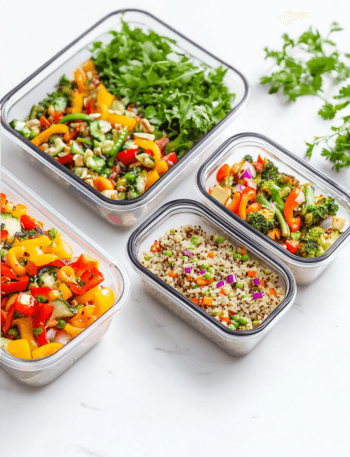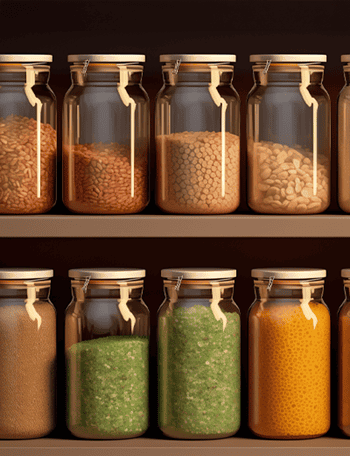Welcome to Your Gluten-Free Vegan Kitchen!
Embarking on a gluten-free and vegan lifestyle can feel overwhelming, but setting up a well-stocked pantry is the key to success. This guide will walk you through the essential ingredients, tools, and tips for creating a gluten-free, vegan pantry that makes delicious and nutritious meals a breeze. Whether you’re a seasoned plant-based eater or just starting your journey, this resource will empower you to confidently navigate the world of gluten-free vegan cooking.
FTC Disclosure: This website is supported by advertising and affiliate marketing. This means that when you click on links to various merchants on this site and make a purchase, I can make a commission. As an Amazon Associate, I earn from qualifying purchases. I also participate in other affiliate programs and may earn from qualifying purchases or advertisements. These commissions help me maintain this website and provide you with free content. Rest assured that I only recommend products or services that I personally use or believe are of high quality.
A Well-Stocked Pantry: Your Gluten-Free Vegan Foundation
A Well-Stocked Pantry: Your Gluten-Free Vegan Foundation
A well-stocked pantry is the foundation of any successful kitchen, and building a gluten-free and vegan pantry is no different. Having the right ingredients on hand makes meal preparation easier, faster, and more enjoyable. Here are some must-have gluten-free and vegan staples to get you started:
Gluten-Free Flours:
A blend of gluten-free flours is essential for baking delicious cakes, cookies, breads, and other treats. Instead of relying on just one type of flour, using a blend mimics the properties of gluten and provides better texture and structure in baked goods. Some common gluten-free flours include:
- Almond Flour: Made from ground almonds, it adds a nutty flavor and moist texture to baked goods.
- Tapioca Starch/Flour: Provides a light and airy texture and helps bind ingredients.
- Brown Rice Flour: A versatile flour that can be used in a variety of recipes.
- Oat Flour: Made from ground rolled oats, it adds a slightly sweet flavor and chewy texture. (Link to a blog post about oat flour recipes)
- Gluten-Free Flour Blend: Many pre-made gluten-free flour blends are available, offering a convenient option for baking. (Link to a review of gluten-free flour blends or a comparison)
![]()
Vegan Protein Sources:
Protein is essential for a healthy diet, and there are plenty of plant-based options to choose from:
- Lentils: A versatile legume that can be used in soups, stews, salads, and curries.
- Chickpeas (Garbanzo Beans): Great for hummus, falafel, and adding to salads or roasted as a snack.
- Black Beans: Perfect for burritos, tacos, and black bean burgers.
- Tofu: Made from soybeans, it can be used in stir-fries, scrambles, and as a meat substitute.
- Tempeh: A fermented soybean product with a nutty flavor and firm texture, great for stir-fries and sandwiches.
- Edamame: Young soybeans, delicious steamed or added to salads and stir-fries.
- Seitan: A wheat gluten-based protein (not gluten-free but a common vegan protein), but since this guide is for gluten-free vegans, you might mention it briefly and then emphasize the gluten-free alternatives.
Grains & Starches:
These add variety and essential nutrients to your meals:
- Quinoa: A complete protein and a good source of fiber.
- Brown Rice: A nutritious and versatile grain.
- Oats (Rolled or Steel-Cut): Great for breakfast, baking, and adding to smoothies.
- Sweet Potatoes: A delicious and nutritious root vegetable.
- Potatoes: A versatile and affordable starch.
- Corn: Cornmeal, polenta, and popcorn are great additions to a gluten-free vegan pantry.
Nuts & Seeds:
These provide healthy fats, fiber, and protein:
- Almonds: Great for snacking, baking, and making almond butter.
- Walnuts: A nutritious and flavorful nut.
- Chia Seeds: A good source of omega-3 fatty acids and fiber.
- Flax Seeds: Also a good source of omega-3s and fiber, and can be used as an egg replacement in baking.
- Pumpkin Seeds (Pepitas): A nutritious and crunchy snack.
- Sunflower Seeds: Another great snacking option and can be used in baking.
Canned Goods:
These are pantry staples for quick and easy meals:
- Canned Beans (Black beans, kidney beans, chickpeas, etc.): A convenient source of protein and fiber. Always check labels to ensure they are gluten-free certified.
- Canned Tomatoes (Diced, crushed, sauce): Essential for sauces, soups, and stews. Check labels for gluten-free certification.
- Coconut Milk: Used in curries, desserts, and smoothies. Check labels.
- Vegetable Broth: A base for soups, stews, and sauces. Check labels.
Spices & Herbs:
Spices and herbs are the secret weapons in any kitchen, and a well-stocked spice rack can elevate even the simplest dish. Here’s a guide to some common and versatile spices and herbs, grouped by flavor profile to help you navigate the world of culinary seasonings:
Warm & Earthy:
- Cumin: A warm, earthy spice common in Mexican, Indian, and Middle Eastern cuisine.
- Coriander: The seeds of the cilantro plant, offering a citrusy and slightly sweet flavor.
- Chili Powder: A blend of spices that adds heat and depth to chili, stews, and sauces.
- Paprika: Made from dried peppers, ranging from sweet to smoky to hot.
- Cinnamon: A sweet and warming spice, perfect for baked goods and beverages.
- Ginger: A pungent and slightly sweet root, used in both sweet and savory dishes.
Herbs de Provence:
A classic blend of dried herbs from the South of France, ideal for Mediterranean dishes.
- Thyme: A delicate, earthy herb with a slightly minty flavor.
- Rosemary: A pungent, piney herb that pairs well with meats and vegetables.
- Oregano: A strong, savory herb common in Italian and Greek cuisine.
- Marjoram: A sweet and floral herb, similar to oregano but milder.
- Savory: A peppery herb that complements beans and stews.
Italian Herbs:
Aromatic herbs that bring the flavors of Italy to your kitchen.
- Oregano: (See above)
- Basil: A sweet and fragrant herb, essential for pesto and tomato-based sauces.
- Rosemary: (See above)
- Thyme: (See above)
- Parsley: A fresh and slightly peppery herb, often used as a garnish.
Indian Spices:
A complex and flavorful blend of spices that form the foundation of Indian cuisine.
- Turmeric: A vibrant yellow spice with a warm, earthy flavor and anti-inflammatory properties.
- Cumin: (See above)
- Coriander: (See above)
- Garam Masala: A blend of spices that varies by region and family, typically including cinnamon, cardamom, cloves, and black pepper.
- Curry Powder: A pre-made blend of spices, often including turmeric, cumin, coriander, and chili powder.
Mexican Spices:
Spices that bring the heat and flavor of Mexico to your dishes.
- Chili Powder: (See above)
- Cumin: (See above)
- Oregano: (See above)
- Chipotle Powder: Smoked and dried jalapenos, adding a smoky heat to dishes.
Garlic & Onion:
Essential flavor enhancers for almost any cuisine.
- Garlic Powder: A convenient way to add garlic flavor to dishes.
- Onion Powder: A versatile spice that adds onion flavor to sauces, soups, and rubs.
- Garlic Flakes: Dried garlic flakes that offer a more intense garlic flavor.
This is just a starting point, and there are many other spices and herbs to explore. Experiment with different combinations to discover your favorite flavor profiles and create unique and delicious dishes. Don’t be afraid to mix and match spices from different cuisines to create your own signature blends. The possibilities are endless!
Oils & Vinegars:
Essential for cooking and dressings:
- Olive Oil: A healthy and versatile oil.
- Avocado Oil: A good source of healthy fats.
- Apple Cider Vinegar: Used in dressings, sauces, and baking.
- Balsamic Vinegar: Adds a rich flavor to dressings and marinades.
- Tamari (Gluten-Free Soy Sauce): A staple in Asian-inspired dishes.
Sweeteners:
Natural sweeteners for baking and cooking:
- Maple Syrup: A delicious and natural sweetener.
- Agave Nectar: Another natural sweetener.
- Dates (Medjool or Deglet Noor): Can be used to make date paste or added to smoothies and baked goods.
- Coconut Sugar: A less refined sweetener.
Tools & Equipment
Having the right tools can make gluten-free vegan cooking easier and more enjoyable:
- High-Speed Blender: Ideal for smoothies, sauces, and nut butters.
- Food Processor: Great for chopping vegetables, making dips, and processing nuts.
- Baking Sheets & Pans: Essential for baking gluten-free vegan treats.
- Mixing Bowls: A variety of sizes for different tasks.
- Storage Containers: Keep your pantry organized and your ingredients fresh.
Tips for Success:
- Read Labels Carefully: Always check labels to ensure products are certified gluten-free and vegan.
- Start Small: Don’t try to overhaul your pantry all at once. Start with a few essential ingredients and build from there.
- Get Creative: Experiment with different recipes and adapt them to your taste.
- Stay Organized: Keep your pantry organized to avoid buying duplicates and ensure ingredients stay fresh.
Join Our Community
Ready to embrace a delicious and healthy gluten-free vegan lifestyle? Join our community for recipe inspiration, cooking tips, and support. Subscribe to our newsletter for exclusive content and updates!




[…] a complete list of gluten-free vegan pantry essentials, check out our comprehensive […]
[…] budget management. Having a well-stocked pantry is key to creating affordable meals. Check out our Essential Guide to a Gluten-Free Vegan Pantry for a complete list of must-have […]
[…] From gluten-free flours to vegan protein sources, this guide will help you stock your pantry with all the gluten-free vegan pantry essentials. […]